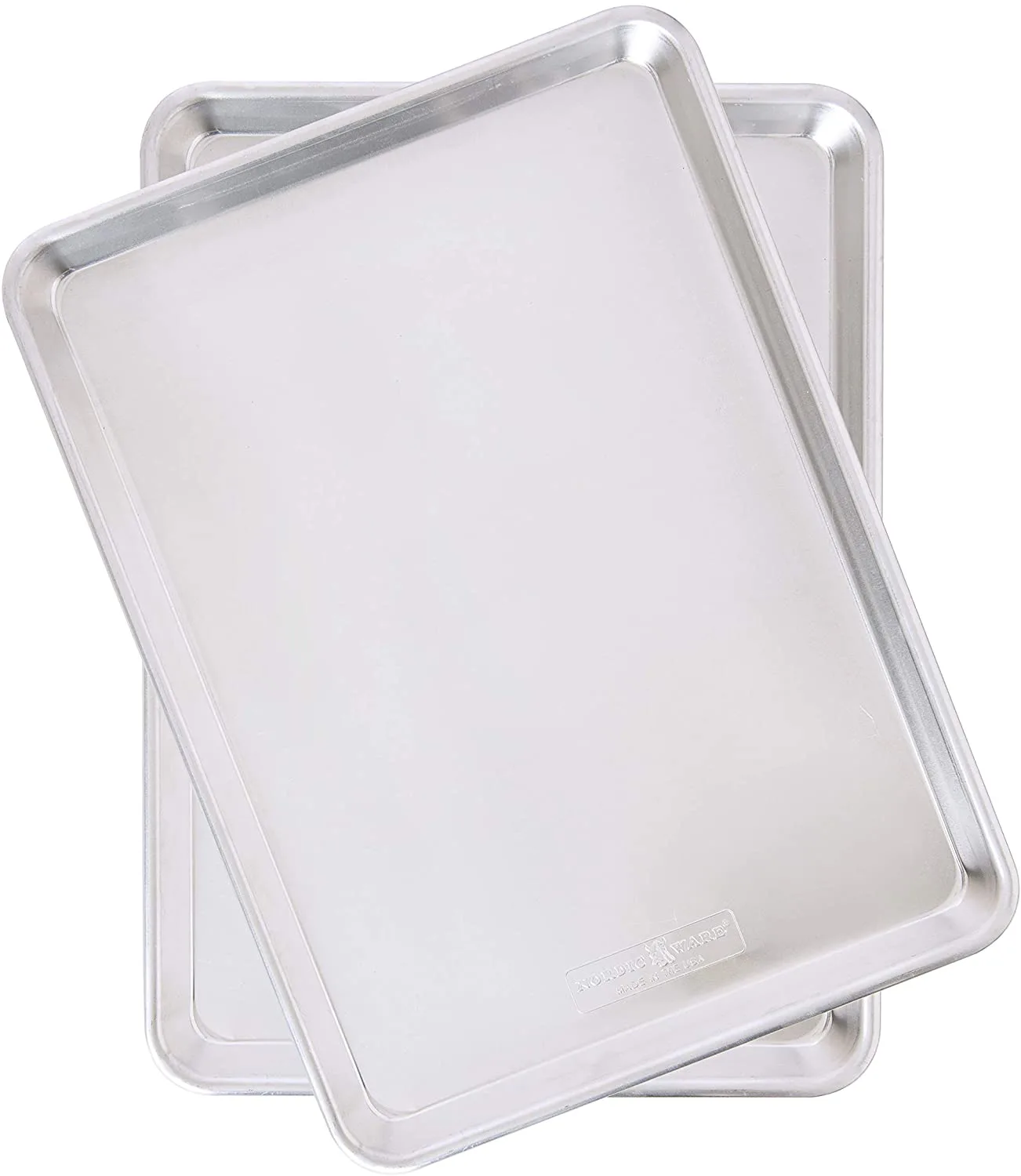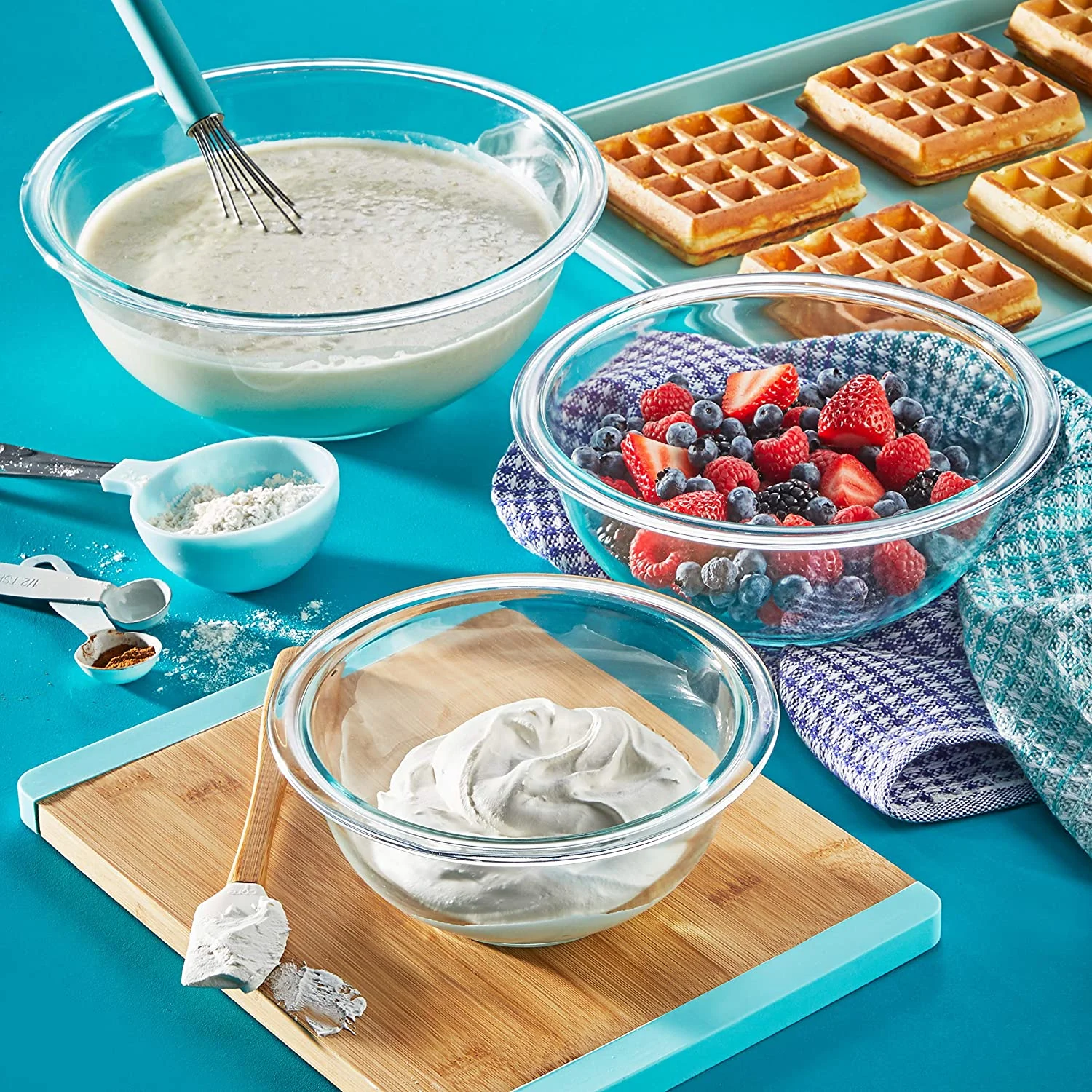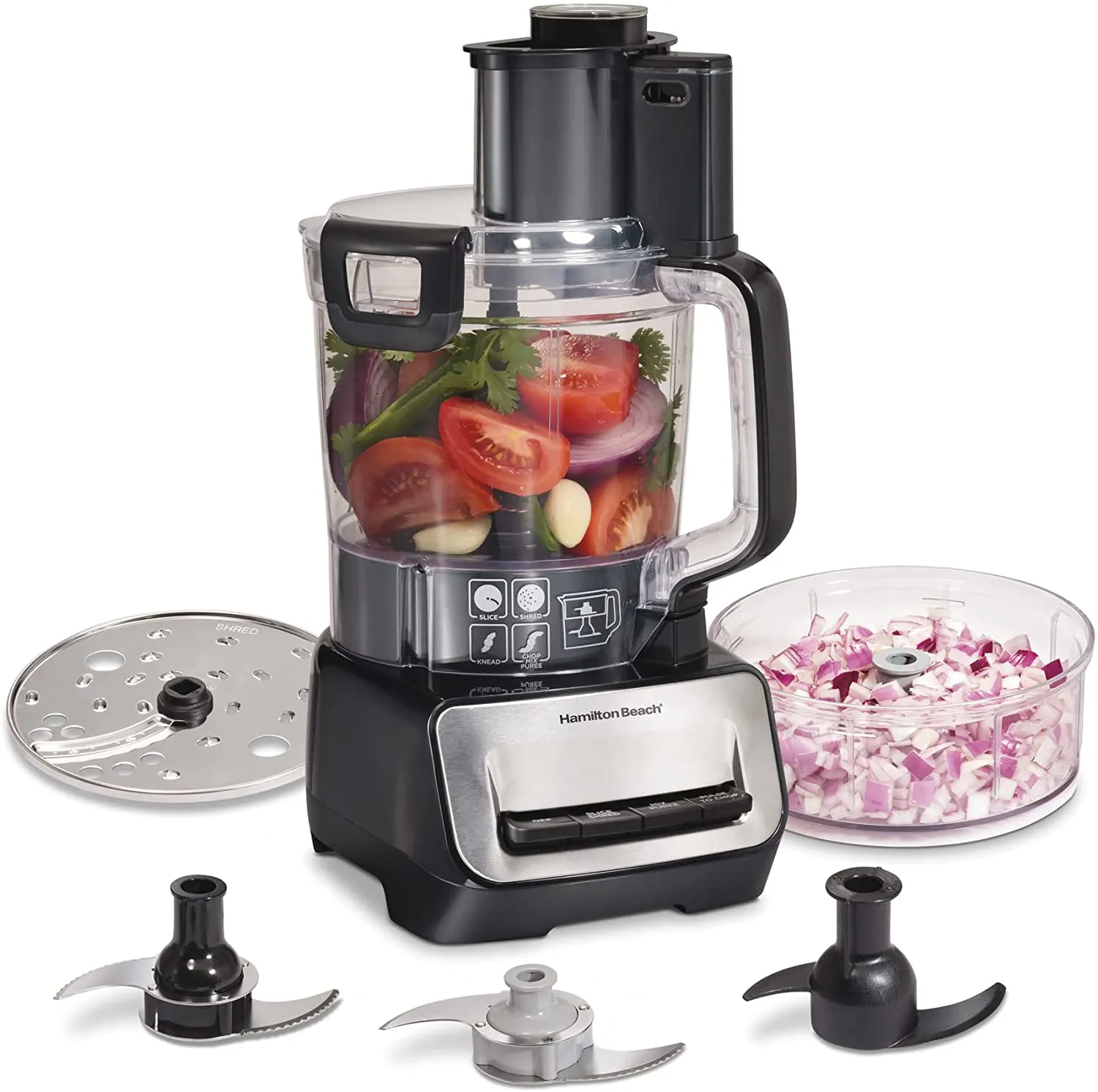Crispy on the outside, soft and buttery on the inside – make traditional English scones at home for a delightful afternoon treat.

I was born in Canada, but was raised in a very culturally English household. One ritual I have always enjoyed was tea on the weekends. We did not follow a typical British meal schedule, but rather a Canadian one so instead of afternoon tea we would have tea and biscuits (cookies) shortly after lunch.
Sometimes, as a real treat, we would have scones with our tea and to be honest, this is still a favourite of mine. There is nothing better than relaxing with a hot cup of tea and a freshly baked scone loaded with delicious clotted cream and jam.
Scones have a magical quality of being both sweet and savory, light and humble – the perfect accompaniment to relax with on a lazy afternoon or enjoy with friends.
Today I want to share with you my English scones recipe. Get your tea kettle warming and break out the clotted cream, because these scones are guaranteed to become your new favorite treat.
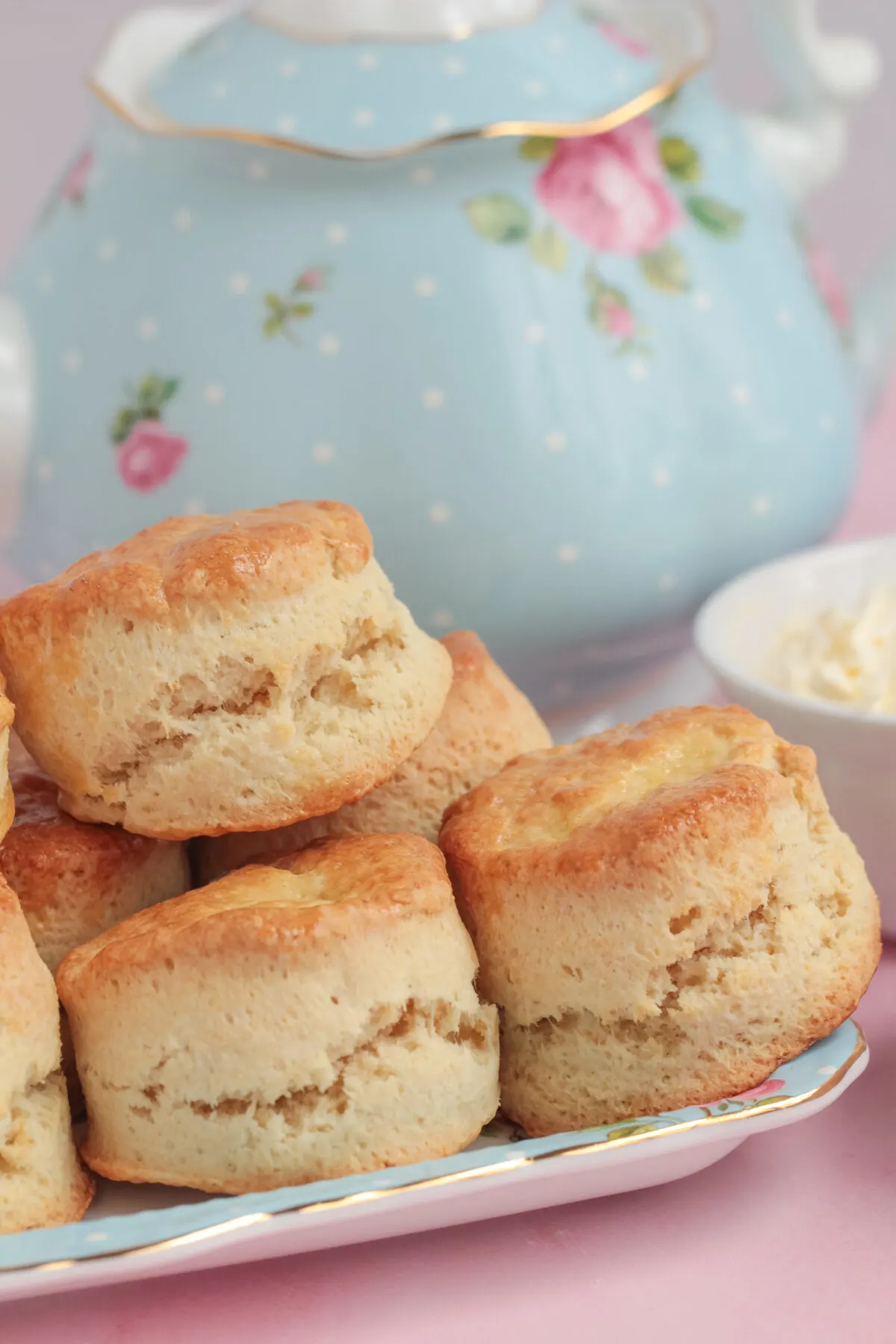
Tips for the BEST Scones
Use heavy cream. Avoid using milk or lower fat cream as this can result in flat scones and less tasty scones.
Your butter, cream, and egg need to be cold. It’s important that your dough is cold in order to get that perfect light and crumbly texture. It also helps to prevent spreading.
Grate your butter. It might be tempting to just cut your cold butter in, but using grated butter ensures that the butter is evenly distributed throughout the dough. This means you won’t need to work the dough as much.
Measure correctly. Spoon and level your flour using a dry measuring cup and the back of a dinner knife.
Don’t overwork your dough. You want to really minimise the amount of time you handle the dough. Work it just enough to form a cohesive ball you can form a disc with. Overworking the dough will a result in a dense scone.
Your discs should be thick. You want your discs to be about 3/4 of an inch thick or even slightly thicker. We want nice and tall scones, and part of this equation is starting off with tall dough.
Only Brush the tops of the scones. We brush the tops of the scones with egg or cream to encourage browning but be careful not to get the sides as it will seal the dough and may prevent your scones from rising nicely.
Don’t twist your cutter. When cutting out the circles, do not twist your cutter or you may seal the dough, prevent a good rise.
How to Store Leftover Scones
Leftover scones normally keep well at room temperature for several days. Wrap them well in plastic wrap or place in a sealable plastic bag once they have cooled to room temperature.
If you need to store them longer you can freeze them instead.
Freeze cut out scone dough circles on a lined baking sheet for about an hour. Once frozen, you can place them in a freezer bag and freeze them up to 3 months. Bake from frozen at 400 degrees Fahrenheit for about 20 minutes, or thaw them in the fridge overnight and bake as directed.
You can also freeze the already baked and cooled scones in a freezer bag or airtight container for up to 3 months.
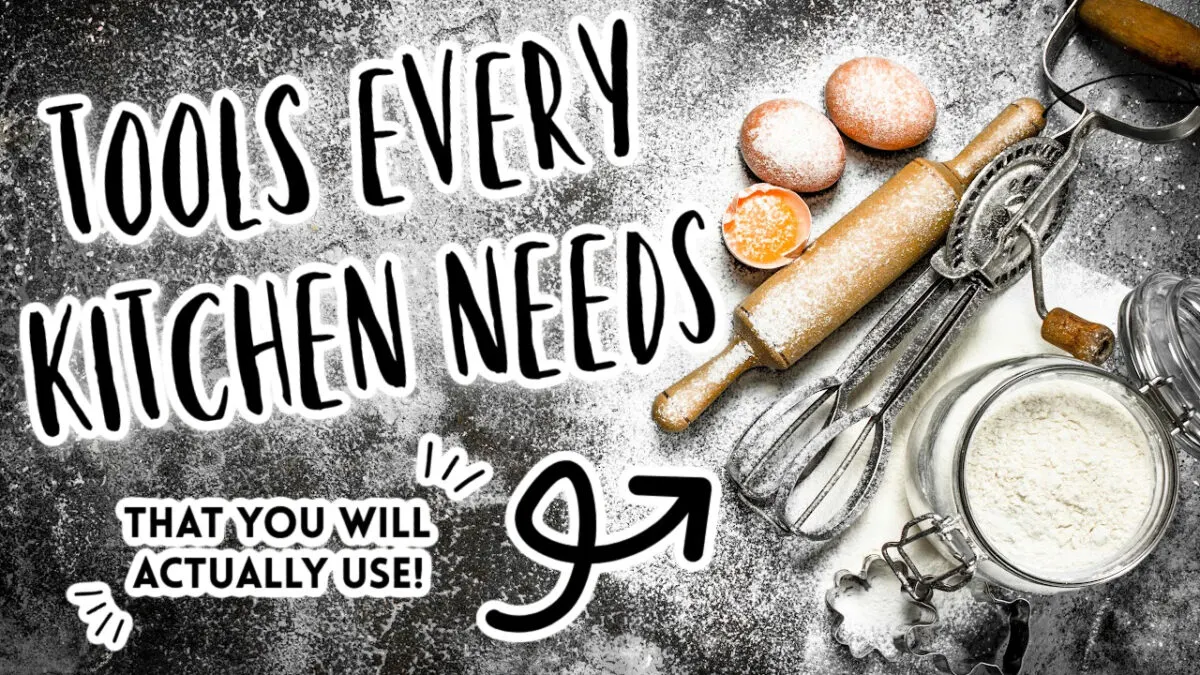
About the Equipment Needed to Make Scones
You really don’t need any special equipment to make scones. Just basic kitchen tools: glass mixing bowls, box grater, 2.5 inch biscuit cutter, baking sheet, parchment paper, and a pastry brush.
Using a food processor, as called for, certainly makes quick work of making the dough and I do recommend using one. That said you can use two knives to cut the butter into the flour, and then combine the dough by hand.
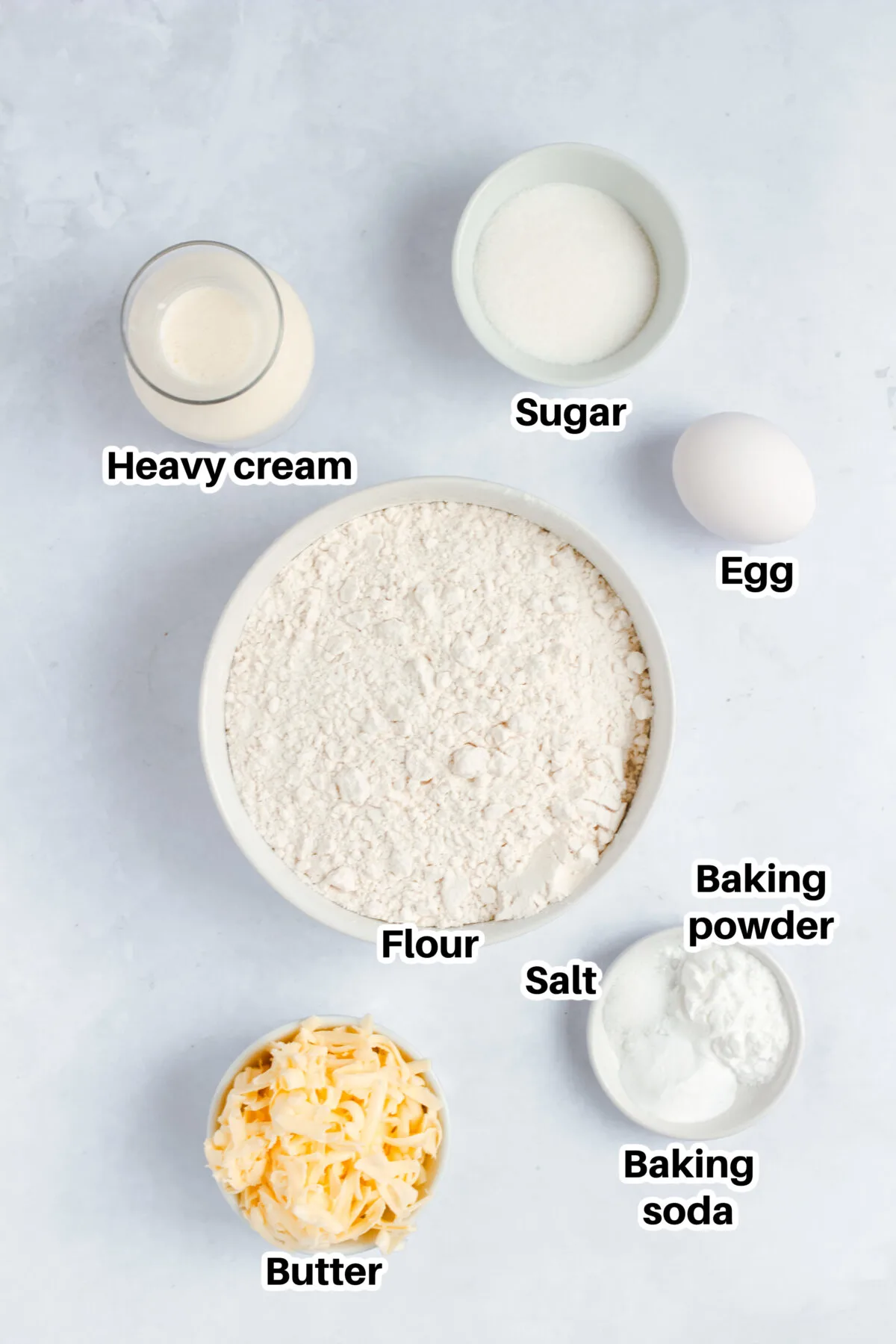
About the Ingredients for Raspberry Scones
Sugar – I use less sugar when making English scones than when I make scones with stuff in them because these are basically a vehicle for jam. I normally use 1/2 cup sugar when making other scones, but for these I personally prefer 1/4 cup of sugar. You may use up to 1/2 cup sugar if you like a sweeter scone.
Flour – We need 3 cups of flour for the dough, but you will need extra for flouring your clean work surface and hands.
Baking powder & baking soda – To leaven the dough, make sure they are still active.
Salt – Adds flavour.
Butter – You should use unsalted butter, but I always make my scones with salted butter and then halve the additional salt. Do not replace with another fat. Butter gives the scones their flaky, crisp texture as well as their rich flavour. Make sure it is cold or frozen. Frozen butter is easier to grate but fridge temperature butter is OK too, and easier to work with if you are making the dough without a food processor.
Cream – You absolutely do need to use heavy cream here. Yes, you can make scones with buttermilk or other types of milk but the fat from 35% milk fat cream gives the best flavour and texture. Make sure it is cold.
Egg – Adds flavour and structure to the scones. Should be cold. I use one egg in the batter, and one egg for the egg wash. Egg may be omitted if you like, but you will need to replace it about three tablespoons of cream. You can also use cream for the wash instead of egg. It will help with browning, but you won’t get the glossy look.
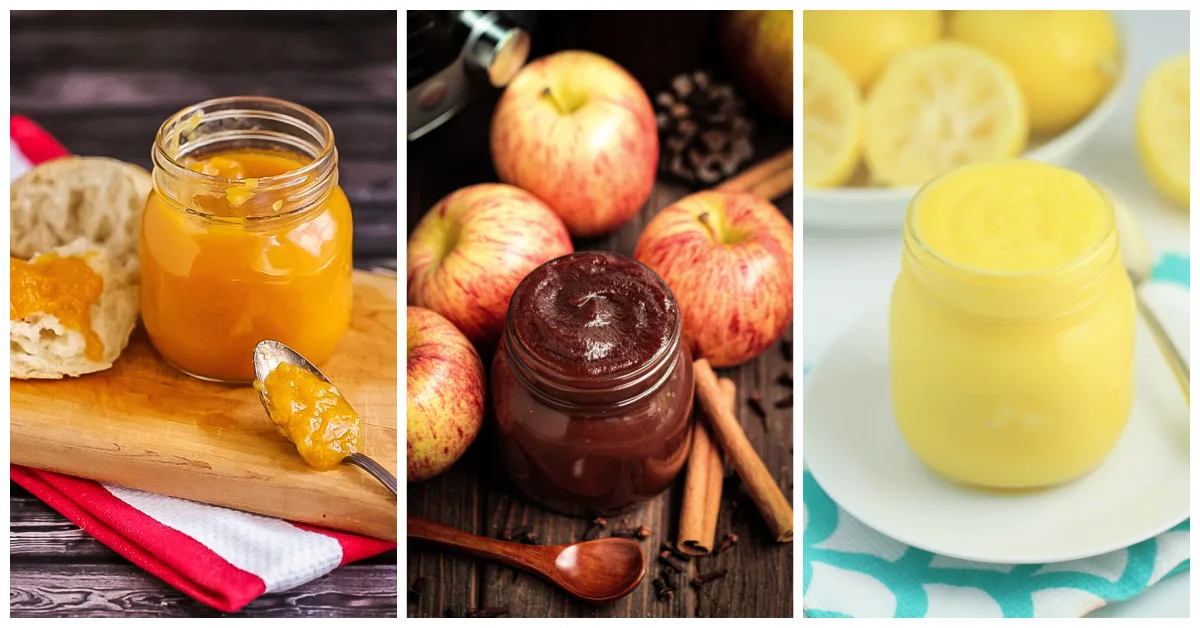
What to Serve with English Scones
Scones are a classic British treat that can be enjoyed for breakfast or afternoon tea.
Clotted Cream and Jam
The traditional way to serve scones is with clotted cream and jam. Clotted cream, also known as Devonshire or Cornish cream, is a thick, rich and indulgent dairy product made by slowly heating heavy cream. It has a velvety texture and tastes like a very creamy cross between butter and whipping cream.
To serve, simply split the scone in half and spread clotted cream on one half and jam on the other. Some people prefer to put the jam first, followed by a dollop of clotted cream, while others do it the other way around. Whichever way you choose, this classic combination is a must-try when serving English scones.
Strawberry jam is a classic choice here, but any jam will do. I love using my peach jam in the summer, or apple butter in the fall.
Butter
Clotted cream is expensive and not easy to find in Canada, and while absolutely worth the cost for a treat, I sometimes settle for just salted butter instead.
Lemon Curd
For a tangier option, lemon curd is another great topping for scones. This creamy and zesty spread is made with butter, eggs, sugar and lemon juice, creating a rich and velvety texture with a burst of citrus flavour. Lemon curd pairs well with the buttery and slightly sweet taste of scones, making it a refreshing alternative to jam.
To serve, simply spread a generous amount of lemon curd over the halved scones.
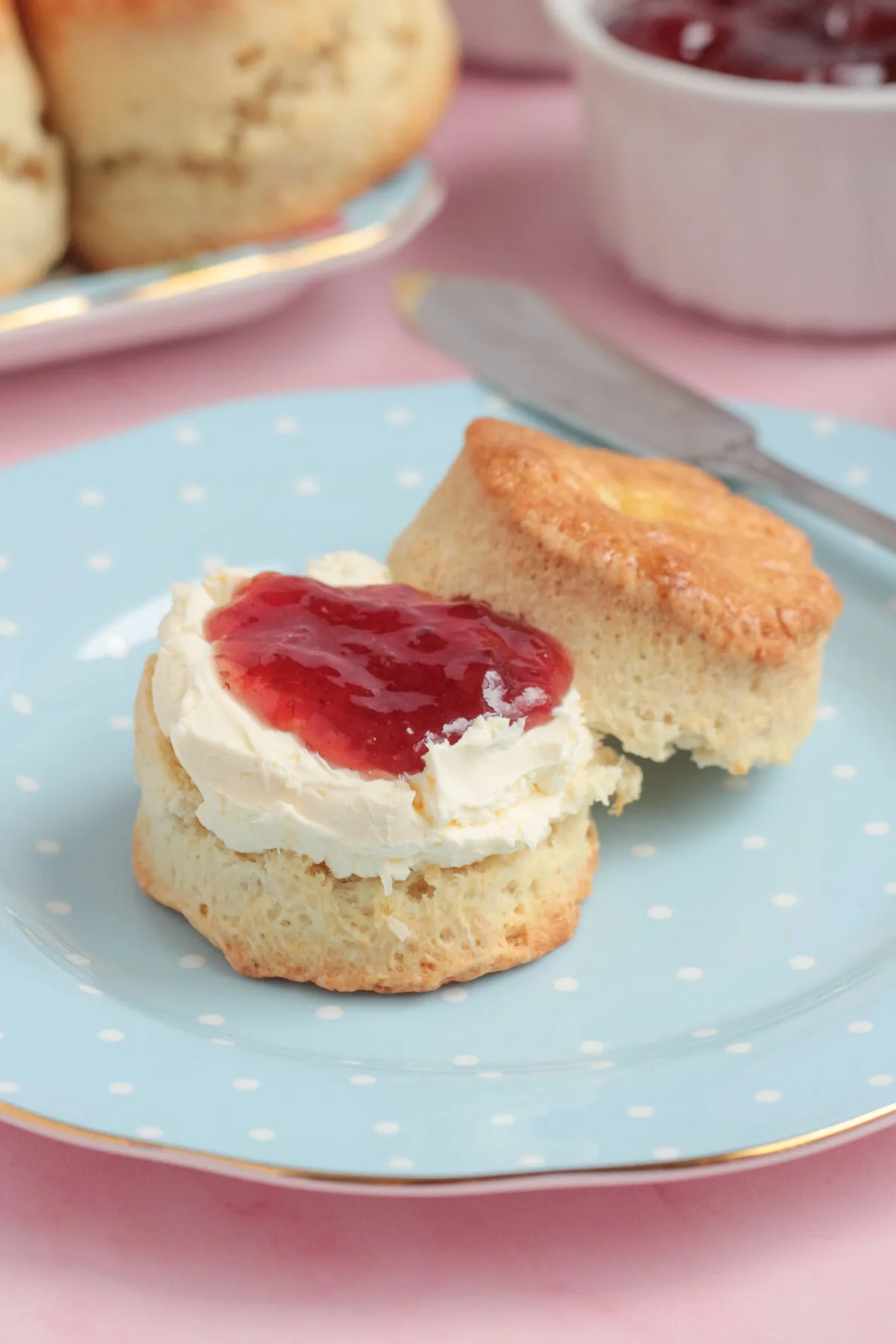
How to Make English Scones
Yields: 16 Scones | Prep time: 15 minutes | Bake time: 14 Minutes | Chill time: 15 Minutes
Ingredients:
- 1/4 cup (38 g) Granulated sugar
- 3 cups (360 g) All-purpose flour
- 2 teaspoons (10 g) Baking powder
- 1 teaspoon (5 g) Baking soda
- 1/2 teaspoon (2 g) salt
- 1/2 cup (113 g) Butter, cold
- 2 large Egg, cold
- 1 cup (250 mL) Heavy whipping cream, cold
Directions:
Line a large baking sheet with parchment paper or a silicone baking mat, and set aside.
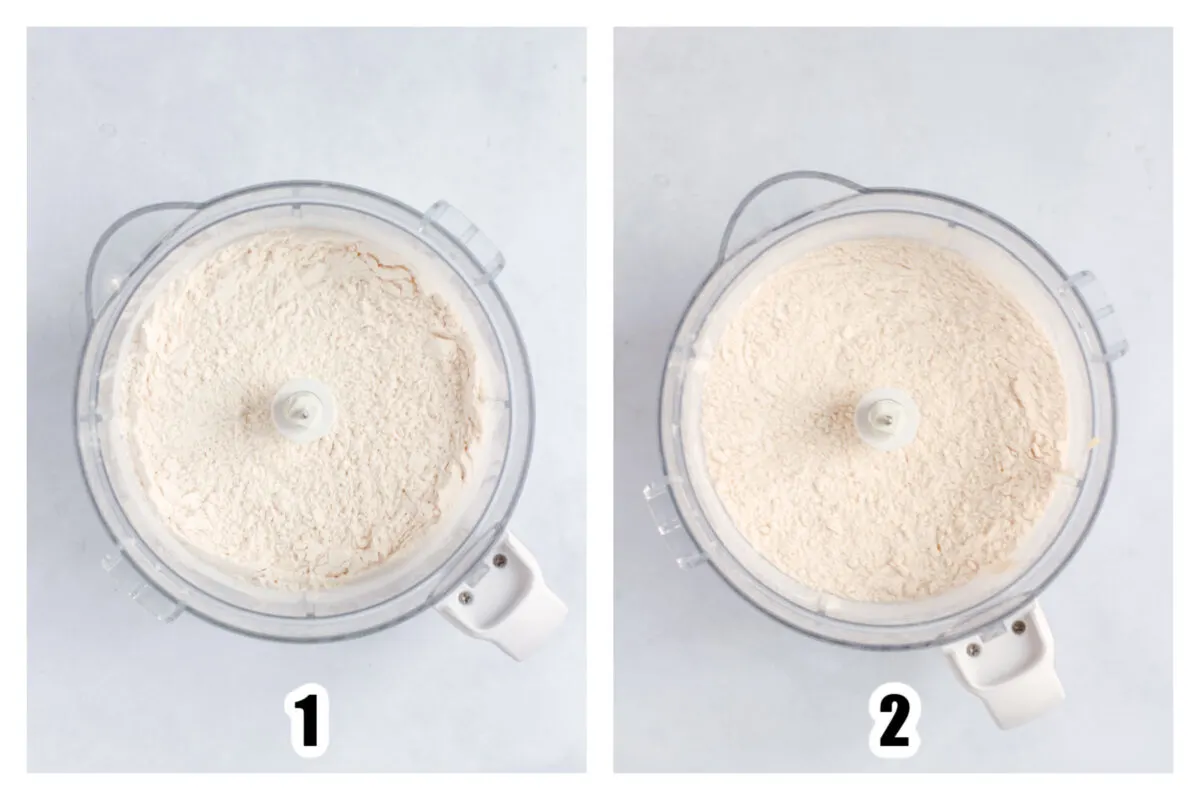
In a large mixing bowl, whisk together sugar, 3 cups flour, baking powder, baking soda, and salt.
Use a box grater to grate the cold butter.
Place the flour mixture and butter into a food processor, and pulse until well combined. (Images 1 & 2)
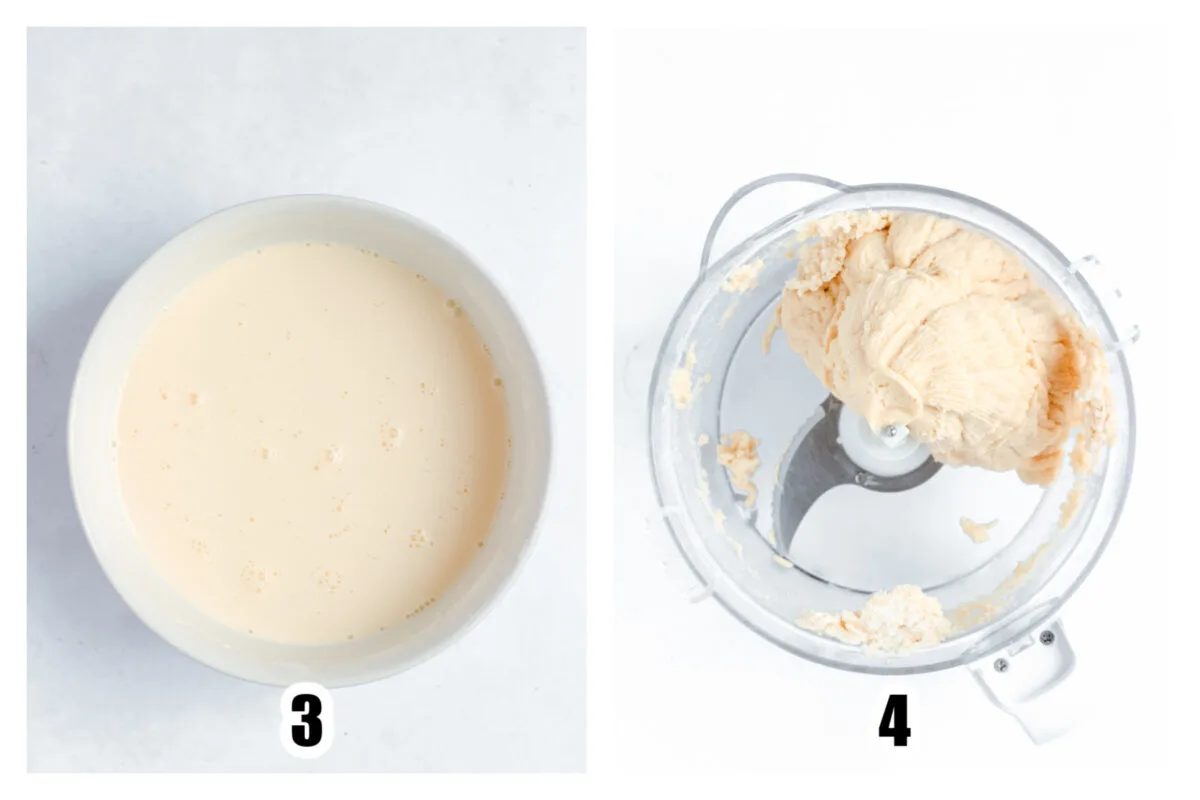
In a small bowl, whisk together one egg with the cream. (Image 3)
Pour in the cream mixture, and combine using the kneed setting on your food processor until a dough forms. The dough should not be sticky. (Image 4)
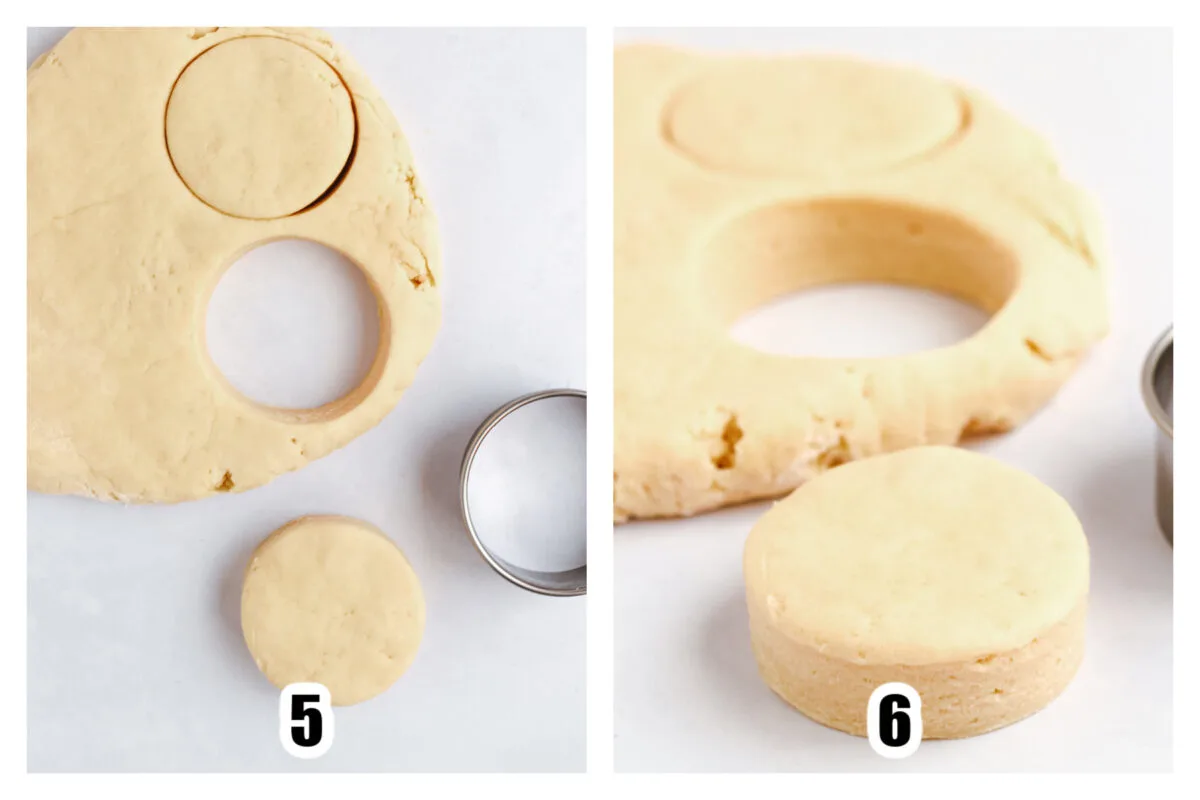
Divide the dough in half, turning out one half onto a lightly floured surface. Working quickly, lightly knead the dough into a smooth ball, and then roll out to about 3/4 of an inch thick. Repeat with the other half of the dough on your floured work surface.
With a 2.5 inch biscuit cutter, cut out your scones from the dough, being carefully not to twist the cutter as you press down. Roll the dough out again until all the dough has been used. (Images 5 & 6)
Arrange the circles on your prepared baking sheet, about 2 inches apart. Place in fridge for at least 15 minutes to chill.
Preheat oven to 400°F.
Brush the tops with egg, then bake for 12-14 minutes, or until golden brown around the edges and lightly browned on top.
Transfer to a wire rack for about 5 minutes.
Serve warm with clotted cream, or butter and jam.
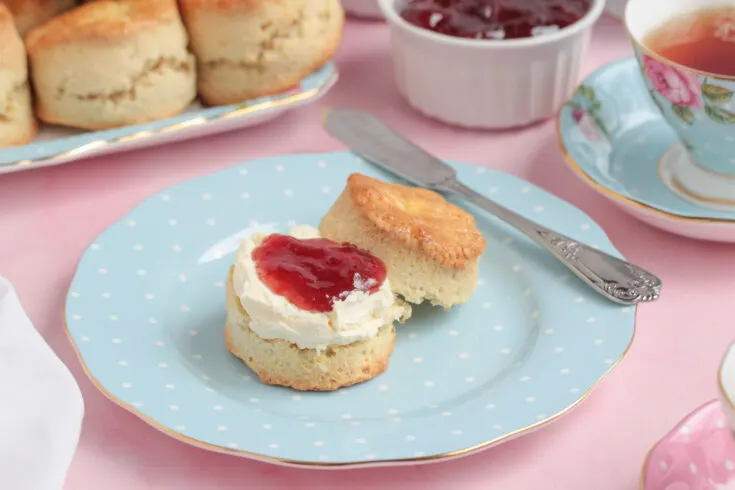
English Scones
Crispy on the outside, soft and buttery on the inside – make traditional English scones at home for a delightful afternoon treat.
Ingredients
- 1/4 cup (38 g) Granulated sugar
- 3 cups (360 g) All-purpose flour
- 2 teaspoons (10 g) Baking powder
- 1 teaspoon (5 g) Baking soda
- 1/2 teaspoon (2 g) salt
- 1/2 cup (113 g) Butter, cold
- 2 large Egg, cold
- 1 cup (250 mL) Heavy whipping cream, cold
Instructions
- Line a large baking sheet with parchment paper or a silicone baking mat, and set aside.
- In a large mixing bowl, whisk together sugar, 3 cups flour, baking powder, baking soda, and salt.
- Use a box grater to grate the cold butter.
- In a small bowl, whisk together one egg with the cream.
- Place the flour mixture and butter into a food processor, and pulse until well combined.
- Pour in the cream mixture, and combine using the kneed setting on your food processor until a dough forms. The dough should not be sticky.
- Divide the dough in half, turning out one half onto a lightly floured surface. Working quickly, lightly knead the dough into a smooth ball, and then roll out to about 3/4 of an inch thick. Repeat with the other half of the dough on your floured work surface.
- With a 2.5 inch biscuit cutter, cut out your scones from the dough, being carefully not to twist the cutter as you press down. Roll the dough out again until all the dough has been used.
- Arrange the circles on your prepared baking sheet, about 2 inches apart. Place in fridge for at least 15 minutes to chill.
- Preheat oven to 400°F.
- Brush the tops with egg, then bake for 12-14 minutes, or until golden brown around the edges and lightly browned on top.
- Transfer to a wire rack for about 5 minutes.
- Serve warm with clotted cream, or butter and jam.
Recommended Products
As an Amazon Associate and member of other affiliate programs, I earn from qualifying purchases.
Nutrition Information:
Yield:
16Serving Size:
1 sconeAmount Per Serving: Calories: 111Total Fat: 2gSaturated Fat: 1gTrans Fat: 0gUnsaturated Fat: 1gCholesterol: 25mgSodium: 11mgCarbohydrates: 20gFiber: 1gSugar: 3gProtein: 3g
This information is provided as a courtesy and for entertainment purposes only. This information comes from online calculators. Although frugalmomeh.com attempts to provide accurate nutritional information, these figures are only estimates.

Elizabeth Lampman is a coffee-fuelled Mom of 2 girls and lives in Hamilton, Ontario. She enjoys travelling, developing easy recipes, crafting, taking on diy projects, travelling and saving money!




